The Southern Pacific Railroad
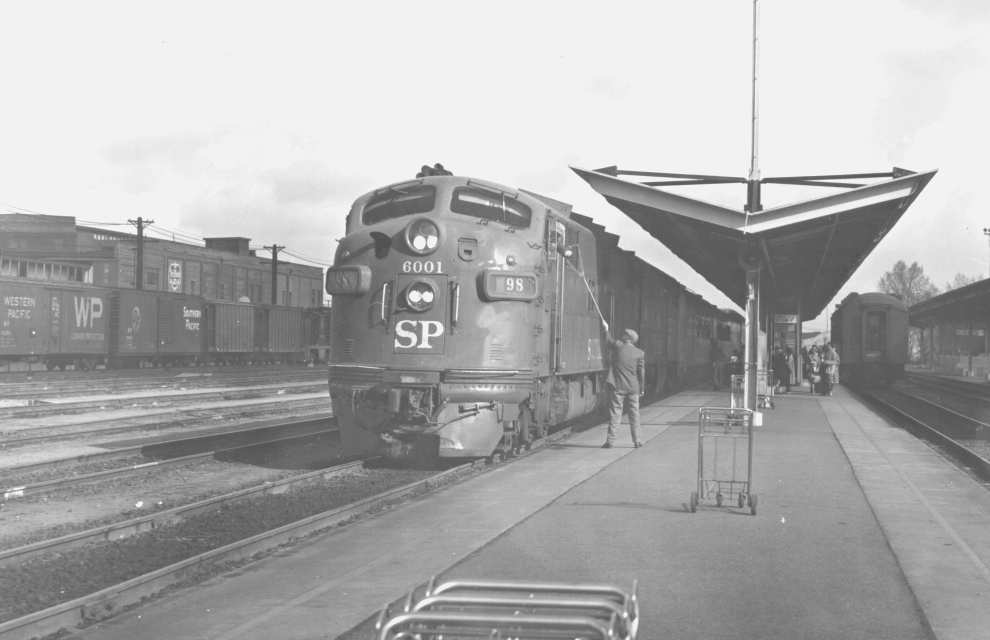
The photograph above was taken, by me using an old 4/5 Speed Graphic camera, on the station platform at the San Jose passenger depot probably about 1960. There are several things to note in the photo. 1. the photo could never be duplicated because the passenger train #98 does not run any longer. This train was known as the "Daylight" and ran from San Francisco and Los Angeles. The train operated daily leaving San Francisco in the morning and arriving Los Angeles in the evening. The trip was a delight because it followed the coast line much of the way and when it was not along the coast it was in the oak covered valleys. A companion train #99 operated in the opposite direction, it left Los Angeles at approximately the same time in the morning, with the trains meeting about half way. There were also two additional trains called the "Starlight". The Starlight trains left both Los Angeles and San Francisco in the evening.
These trains were known collectively as the "Streamliners", none of the trains operate any longer and have not for many years. This was near the end of the luxury passenger train era, the airlines were taking over the passenger business. The trains all had dining cars that served real meals cooked on board by fine chefs, there were lounge cars that served drinks of all kinds. private suits, domed cars for viewing the scenery and all in all it was a relaxing enjoyable trip.
The second thing to note is the man standing with what appears to be a slender pole in his hand. This is the telegraph operator at San Jose handing operating orders up to the fireman as the train moves past the operator. The operating orders gives the train permission to operate beyond San Jose on its trip to Los Angeles. The reason I know the train is in motion is because the headlights are illuminated.
The third and last thing is the freight cars in the left of the picture. That is a train entering the freight yard from Los Angeles. Because there is only a single track coming into the yard from the south the freight train must clear the track before the passenger train can leave.
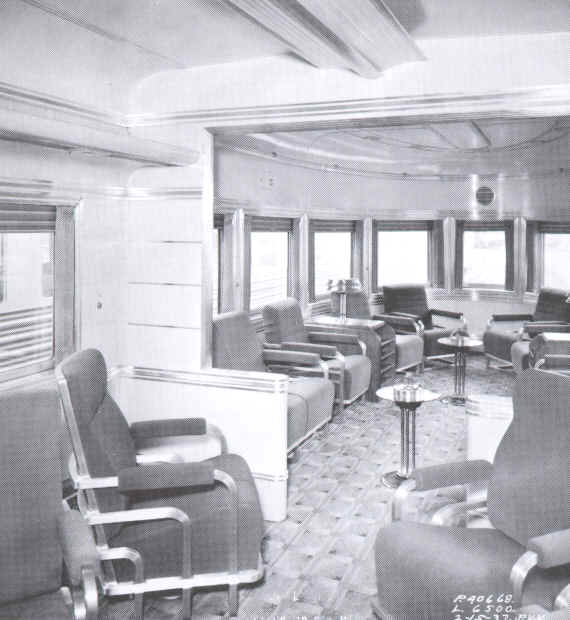
The photo above shows a stand alone ashtray in the parlor car on train #98. The photo below shows an identical ashtray in my study.
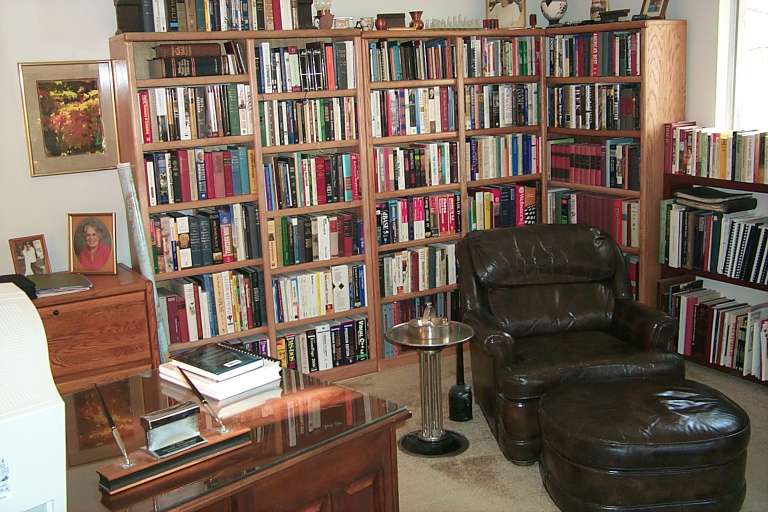
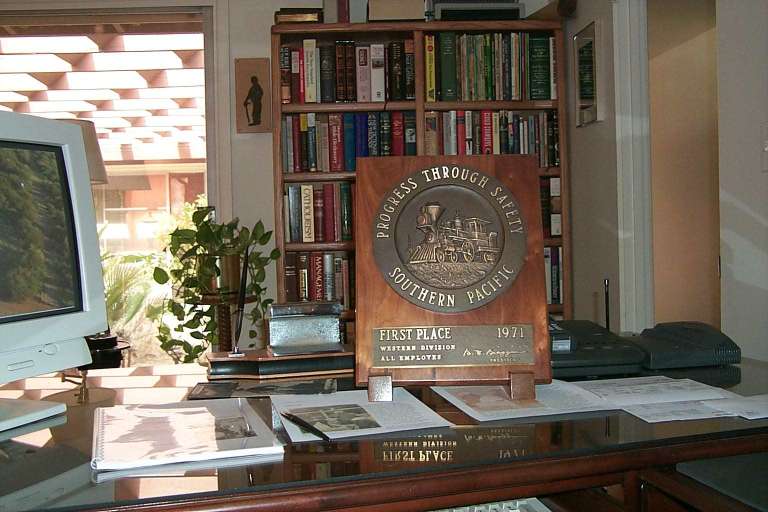
This is a safety award won by the employees on the Southern Pacific, Western Division for the year 1971. The award was first place on the entire Southern Pacific System. All of the employees and officers were very proud of the honor.
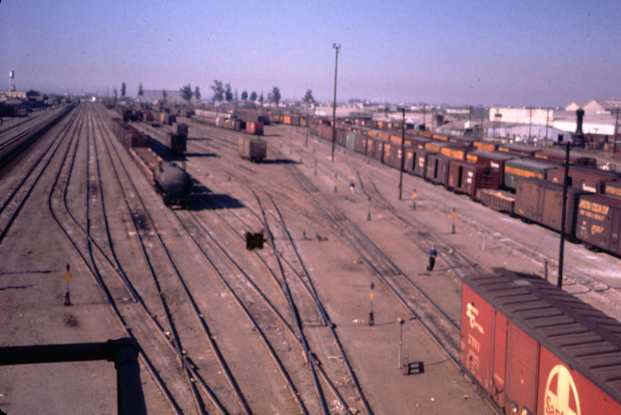
This is a photograph of the San Jose freight yard taken from the yardmasters tower. This picture was most likely taken around the same time as the one of the passenger station. Most of this yard no longer exists. many of the tracks have been removed and replaced with a business office complex. There were other freight yard locations that have also been replaced by commercial developments, this is especially true in San Francisco and Oakland. There was a freight yard in San Francisco called Mission Bay that was converted into a $5.5 billion commercial project. As the railroad freight and passenger business declined the railroad developed the land commercially and because it was often located in the heart of large towns such as Los Angeles, Dallas, Houston, Portland and so on the land was extremely valuable. Just before I left California one of my duties was to decide which railroad property in San Francisco, Oakland and the rest of the Bay area of California could be made available for non-railroad development.
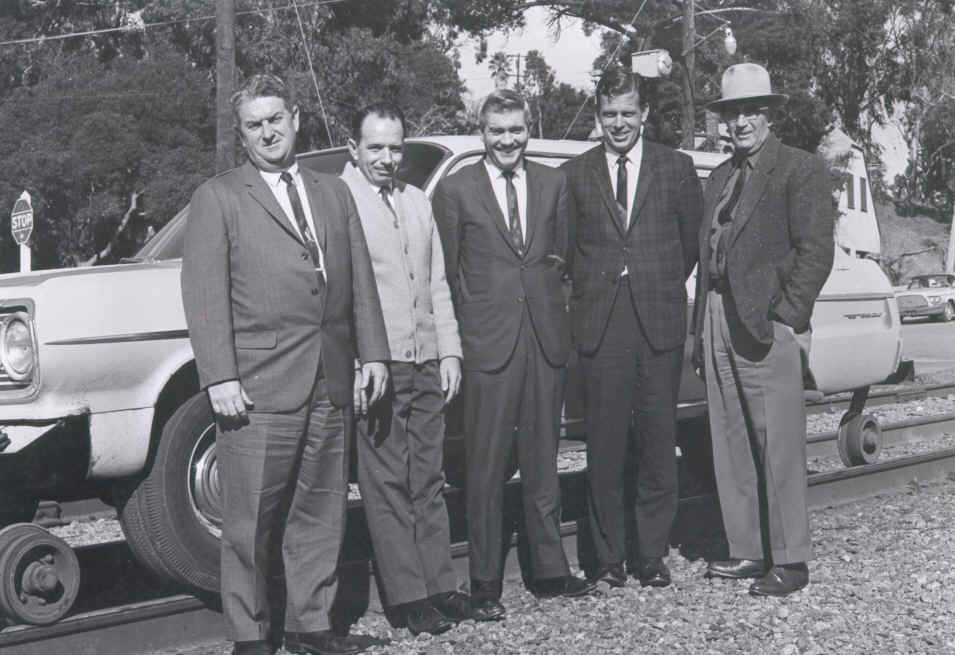
The group above are railroad operating officials from the western division of the S.P. some time around 1966, the vehicle is called a hi-rail car. What that means is that it can operate either on the highway as a normal car or on the railroad tracks. If you will notice, it has railroad guide wheels front and back and is setting on the railroad tracks. That is me second from the right. This vehicle and others like it was used by the division superintendent and his staff for inspection of the railroad. There were basically three modes of transportation for the staff, this vehicle, the business car which is the same railroad car used by presidents when they traveled around the country on their political campaigns. The business car is also known as an observation car.
The business car is very comfortable because it has bedrooms, a kitchen, dining room, and a observation on the rear that allows a very fine view of the railroad behind the train as it travels across the railroad. the drawback to the business car is that it is tied to the rear of the train and is less versatile than the hi-rail which can be taken off the tracks and driven on the highway. The third way to make an inspection is to go out and travel on a train usually on the locomotive. When I rode on the engine I enjoyed operating the locomotive. Of the three I thought the hi-rail was by far the most efficient, it could be operated at passenger train speed and if train congestion became a problem you could take it off the tracks and go on the highway.
The business car was by far the most elegant but not practical when compared to the hi-rail. The black and white photo above was taken in the early 1960's when the hi-rail car was actually a station wagon, in the pictures below that were taken in 80's the hi-rail was a Chevrolet Suburban which was much more sturdy and I thought safer.

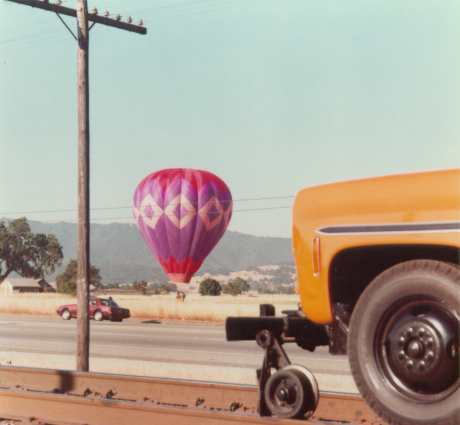
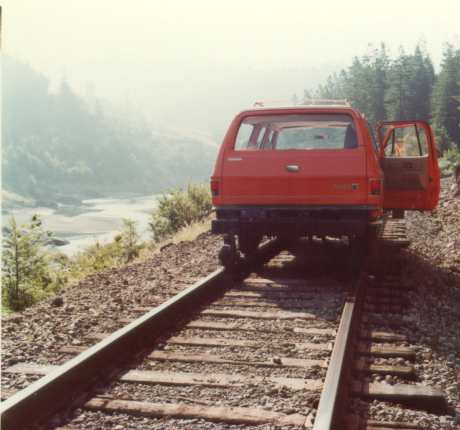
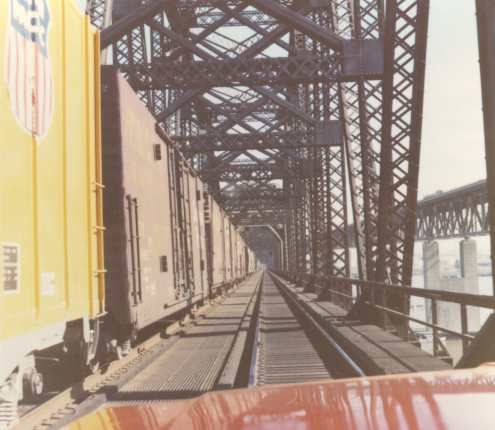
In the photo with the two persons we are waiting in the siding at Bradley, Ca for a train as soon as the train passes we will continue our journey. the one with the hot air balloon is at San Martin, Ca., the one just above on the left where the door is open was taken on the Northwest Pacific Railroad. That is the Eel River below on the left. Finally, the one above on the right is crossing the Martinez Bridge while a train moves in the opposite direction on the adjacent track.
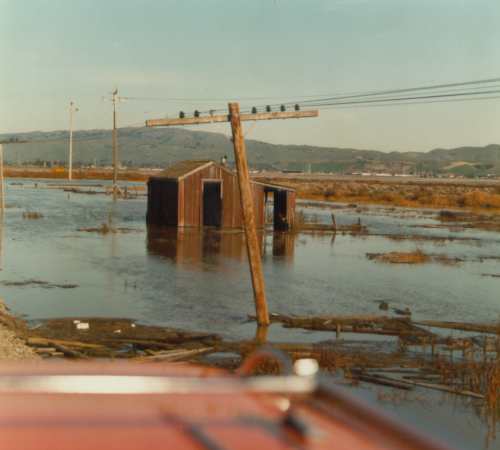
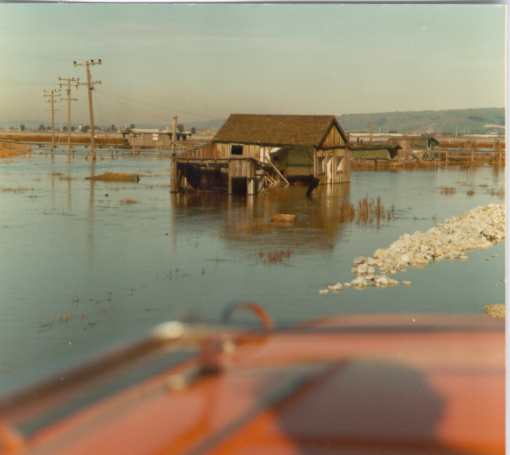
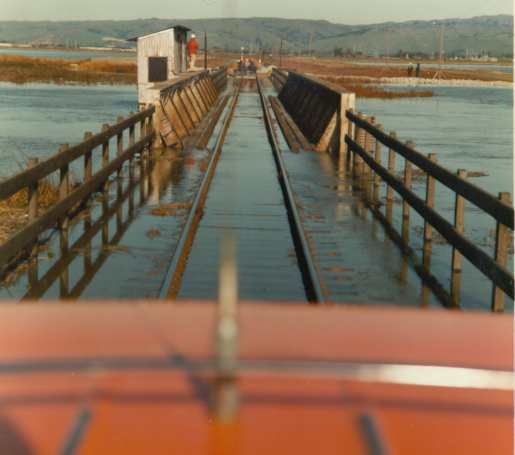

The four photographs above show another advantage to the hi-rail car. The photos were taken from the hi-rail car while on an inspection trip to determine the damage caused by flood waters to the Southern Pacific tracks in central California. Under normal conditions there would be no water visible in any of these locations. It is possible to get to locations easily with the hi-rail car that are almost inaccessible otherwise.
The flooding above is in California during 1983. I did not know it at the time but I would have additional problems related to flooding the next year in Arizona and New Mexico.
Shortly before the above pictures were taken we had an almost tragic derailment of an Amtrak train just after it left the Oakland depot bound for Chicago. We were very fortunate there were no serious injuries even though several cars and locomotives derailed as a result of a washed out culvert.
I used the hi-rail a great deal as a matter of fact in my last year working for the railroad one of my personal goals was to hi-rail all of the main line tracks in my area of responsibility which included all of the states of Arizona and New Mexico, as well as part of Texas. This was an ambitious goal since it covered many hundreds of miles. Finding time to get out of the office and circulate among employees as well as keeping up to date on the physical plant was important but difficult to schedule.
Because of the distances involved I used several types of transportation. If it was necessary to get to a distant location in a short time and if there was a scheduled airline available that was used, if there was not a scheduled airline I used a charter flight. Of course the advantage to the charter flight is that the smaller twin engine planes fly at the same altitude as the airlines and at just about the same speed, the difference is that they will take you to where ever there is an airport available. And it is not necessary for the airport to have a long runway. The charter flights can get into and out of some remarkable places. If even these small planes could not land where it was necessary to get to a helicopter was used. Finally they will wait for you to make the return flight. This was the mode of transportation I used often in Arizona and New Mexico probably at least one flight per week.

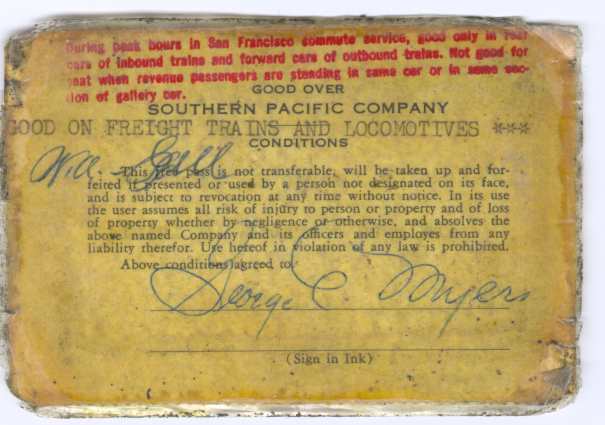
Above is the front and back of one of my passes that allows me to ride on trains including freight trains and locomotives.
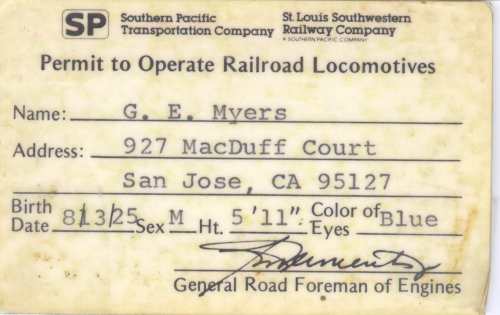
This is my permit to operate locomotives. Even though I never worked as a locomotive engineer I was qualified on any locomotive anywhere on the Southern Pacific system and did operate them when ever I could get out on line with the time. It was a chance to get out of the office and meet the people, it was truly a pleasure and I enjoyed every minute of it.
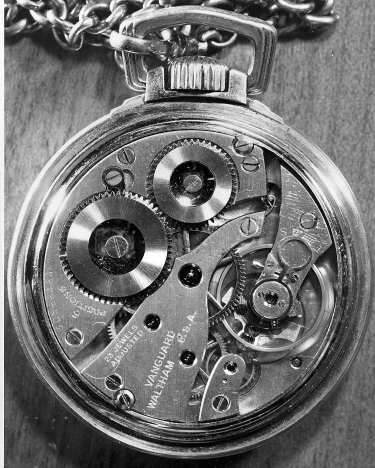
This is my railroad pocket watch. I did not carry this watch the last 25 years I worked because the new railroad approved electric watches were much more accurate and less temperamental.

This is my badge that allowed me into the Southern Pacific General Office Building, Number One Market Street, San Francisco.
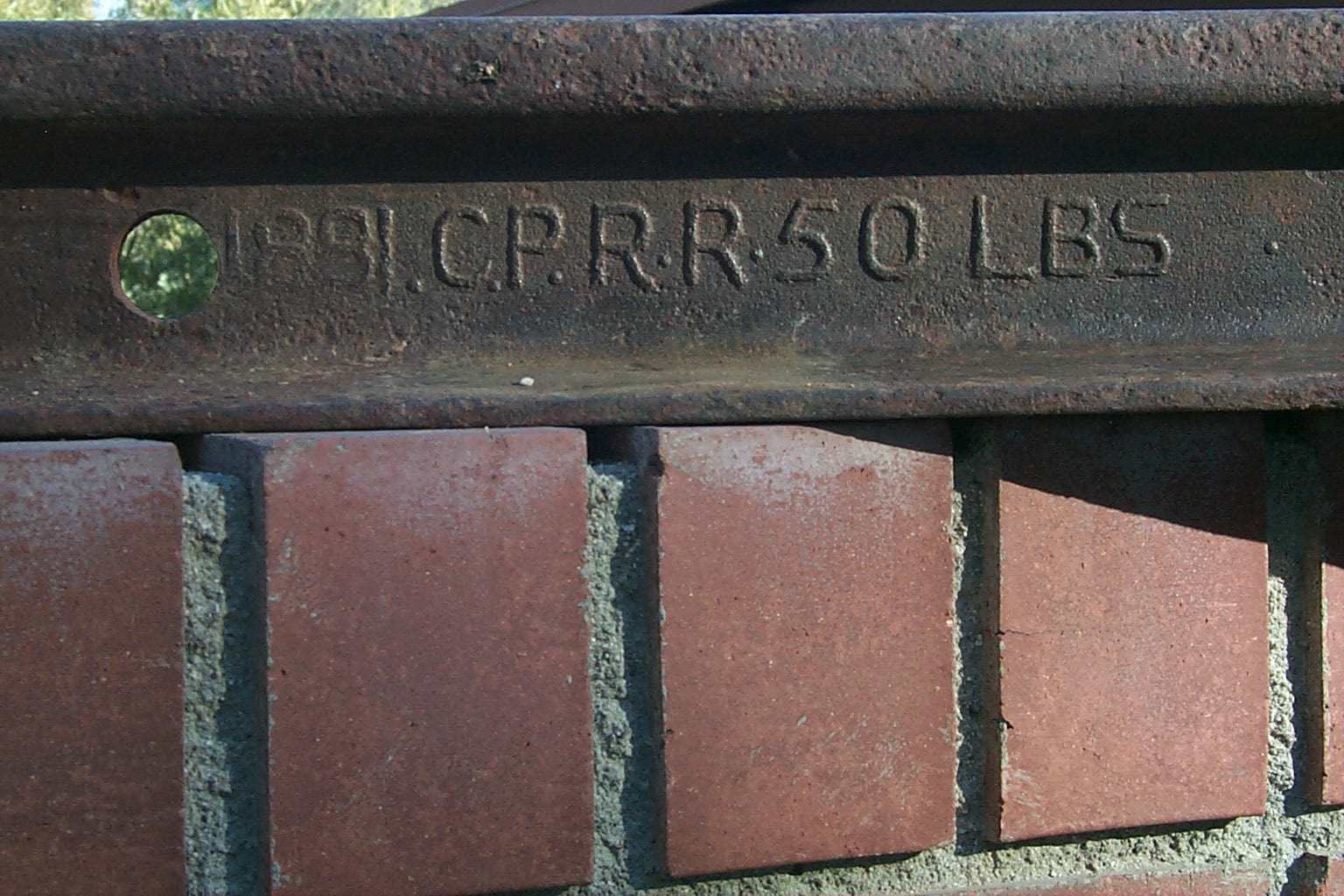
This is a piece of railroad rail that came from the Central Pacific Railroad. The Central Pacific was what the Southern Pacific Railroad was called in the beginning. The Central Pacific and the Union Pacific Railroads were the two that linked the entire Continent together. The Central Pacific started building eastward from Sacramento, California and the Union Pacific started westward from Omaha, Nebraska during the Civil War. The railroads linked together at Promentory, Utah in 1869. Because the war was still being fought at the time the railroad was built both companies used any rail that was available. After the end of the war the inferior rail was replaced as soon as possible with a much better quality. This rail in the photo was a piece of that new rail. On the photo we see 1881 inscribed which was the year the rail was rolled, C.P.R.R. is the Central Pacific Railroad and the 50 pounds is the weight of a 3 foot length of the rail. The number looks a little like 1891 in the picture but on the rail it is clearly 1881.
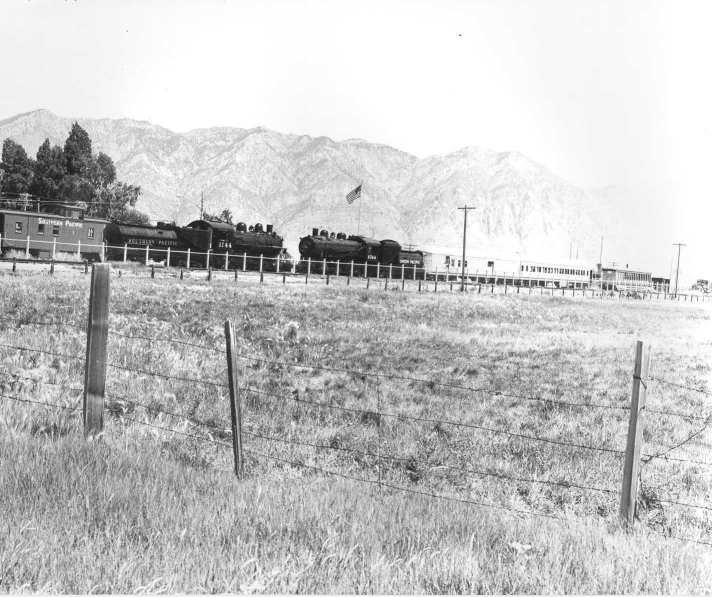
This photograph is a representation of the meeting of the Union Pacific and Central Pacific Railroads at Promentory Point, Utah in 1869. These two trains are located about one mile from the visitors center provided by the National Parks Service. The point above in more nearly the exact location of the driving of the last spike ceremony than where the visitors center is.
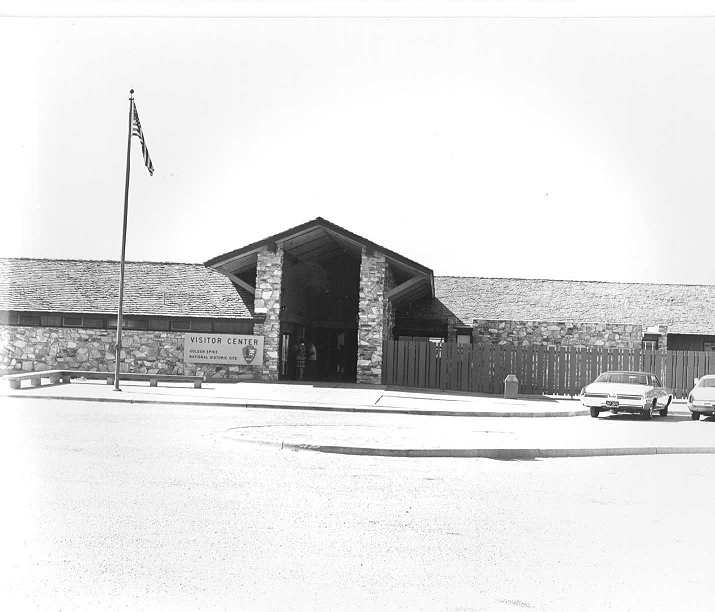
Above is the visitors center
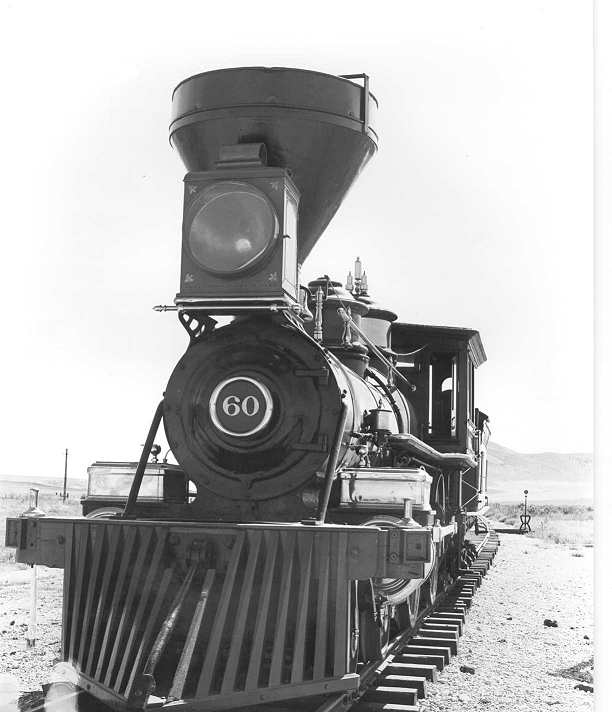
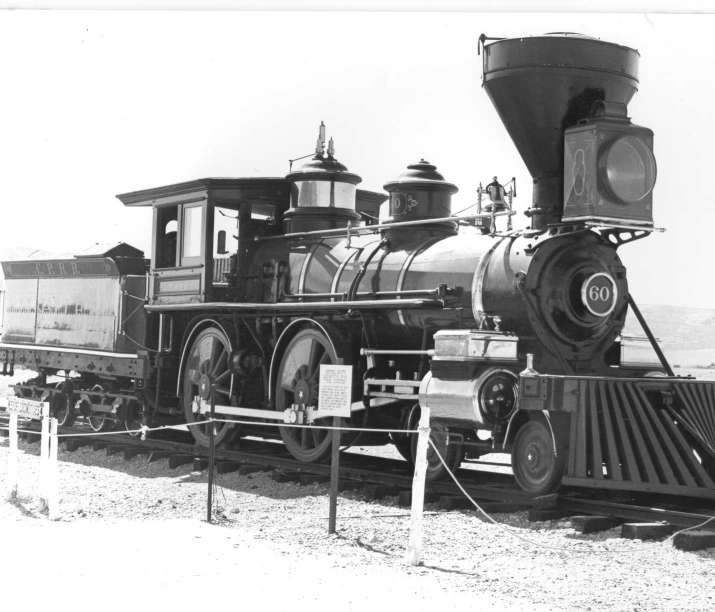
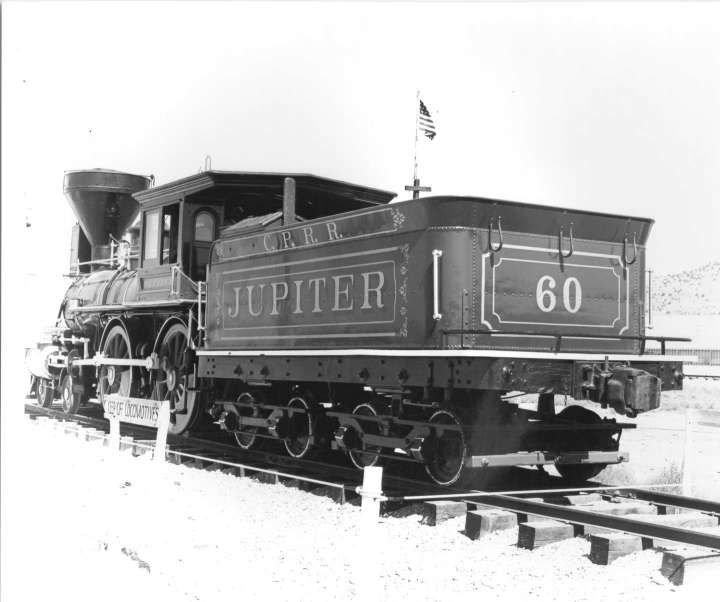
The above photographs are of the Central Pacific Locomotive Jupiter. This locomotive almost did not make it to the ceremony for the photograph taken for the joining of the two railroads back in 1869. On the way to the ceremony the Jupiter which was pulling a special train carrying Central Pacific dignitaries and guests was damaged in a derailment near Donner Lake in the Sierra Nevada Mountains. Repairs to the locomotive were made in Reno, Nevada that allowed it to continue and be present for the ceremony. After the ceremony the engine was used in regular service for many years then scrapped. However the Jupiter was salvaged and rebuilt in the Southern Pacific's locomotive shops in Sacramento, California and is now on display at the National Historic Site.

This is an interesting photograph. I took the picture from a helicopter early in the morning just as the sun was coming up. This is obviously a train that has derailed while crossing a railroad bridge. If you look closely you will see that there is one locomotive setting on the tracks toward the top of the picture. That locomotive crossed the bridge without derailing the next three engines derailed. One of the derailed engines is lying on its side off to the left side of the tracks, the next locomotive is setting upright crosswise to the tracks, the fourth locomotive is at an angle to the right, then there are several cars more or less stacked in a pile draped off the bridge.
In the photo distances are deceiving it looks as if it is only a few feet from the track bed to the sand in the creek. Actually that distance is about 15 feet or more. I should add that even though this would be considered a very expensive derailment mainly because of the cost of cleaning it up and rebuilding the railroad and locomotives it would only rate about a four on a scale of one to ten.
I participated in the cleanup of several in the nine and ten category. These usually involve the public at large, evacuations, hazardous materials, fire and injuries or death to either employees, the public or both. In the more serious situations governmental departments become involved and that is rarely good. In all major derailments and even minor ones that involve the transportation of interstate freight and where there are injuries to persons the Federal Transportation Safety Board sends an investigator to the scene.
In most instances I knew the investigator and because of mutual respect we were able to cooperate and stay out of each others way. In the case of local, state and even federal law enforcement it was often another matter. In many cases they hindered the containment of hazardous materials and the restoration of the railroad by not allowing the railroad to approach the problem site to take corrective measures.
The railroad knew the contents of each car traveling in a train. If there was a car containing hazardous materials any railroad official or employee could get a print out of the name of the material and the characteristics of the substance within minutes and make the information available to the emergency person. Even armed with this information the law enforcement officer would often evacuate the area and keep railroad employees away because he was not sure of his job. As a result the person took what he considered the safe way even though it was often not.
Another problem was what I called the "cowboy syndrome" with the cop being the cowboy. Law enforcement officers are usually aggressive people by nature, that is why they become policeman. Most of their life is spent in what they consider boredom and routine. When something exciting comes along that allows them to show their boss just how smart they are they are not going to pass up their chance of a lifetime. The result is they start shooting from the hip making irresponsible decisions simply to exert their authority.
Its like the California Highway Patrolman that shut the San Francisco Bay bridge down at the start of the afternoon traffic rush hour because he saw a white powdery material on the bridge roadway. The bridge was shut down to all vehicular traffic for several hours until a sample of the powder could be taken to a lab for analysis. I am sure all of us have seen the same white powder many times and continued merrily on our way.
The shutdown caused the largest traffic snarl in the history of the Bay Area. The cop saw his chance to do something exciting and didn't pass it up. The white substance turned out to be Gypsum a perfectly harmless product used as a soil amendment or in construction. The other sad thing to me is that both the head of the California Highway Patrol and the media praised the patrolman for his courage in making a difficult decision. They used the old "what if" thing to justify his actions.
But back to the story, the cause of the derailment shown above was a thunderstorm that occurred the preceding night causing an unusual amount of water to flow under the bridge. As a matter of fact there was more water than the creek bed could handle so water backed up behind the approach on the right hand side at the bridge abutment and eroded the soil and roadbed behind the right hand bay. The erosion of the roadbed caused the track to give way and collapse under the weight of the locomotives thus derailing the train. The miracle is that the lead locomotive that contained the crew crossed without derailing and no one was injured.
Actually there was a second miracle that occurred the next day. Our crews were in the final stages of re-railing all of the cars loaded with cement. The cars that show in the photograph on the bridge had been moved to the left of the picture off the bridge and the last of the cement cars was being hoisted out of the creek bottom in preparation to its being sat onto the bridge.
When there is a major train derailment of this sort all of the TV stations nearby send camera crews to the site to find out what caused the derailment, if there were any hazardous materials in any of the cars in the train, whether anyone was injured and so forth. As the last of the cars was suspended in the air some 20 feet above the ground by two 140 ton cranes I was being interviewed by one of the camera crews from Phoenix that had arrived in a helicopter.
During the interview I was standing with my back to the railroad car being lifted into the air calmly assuring the young lady from the TV station that there was no hazardous materials, no one injured, etc., etc. that this was very routine work just grunt and groan stuff that our people were very proficient at and that within a very short time service would be restored to normal on the railroad.
As I was droning on and on I heard a terrific noise and crash behind me. The young lady's eyes became very large and I thought she would faint. I looked around to discover that one of the cables to a 100 foot boom on one of the cranes had parted or broken. When this cable broke just above where it was attached to the railroad car the remainder of the cable, several hundred feet of it raced through the pulleys at the speed of sound, it was like a black snake, the 100 foot boom collapsed, the railroad car fell to the ground. The additional weight that had been shifted to the second crane picked the rear of it off the ground and I thought it was also going to topple. The thing that saved the second crane was that the cable to that crane became detached from the railroad car as the rear of the crane was lifted into the air and the opposite end of the railroad car hit the ground. All of these events caused a violent movement of the boom to the second crane but the boom did not collapse.
I am still amazed that there were no injuries. I explained to the TV crew that I was sorry but the interview was over because I had pressing duties elsewhere. They seemed happy to hear this and departed in their helicopter. I have no idea what the TV station told their viewing audience when the incident was aired on the 6 o'clock news.
This derailment occurred between Tucson and Nogales, Arizona. In the picture you can see the small amount of surface water in small puddles along side the tracks. The problem in the desert southwest is that when a thunderstorm occurs an awful lot of water can fall in a very short time which results heavy runoff. In this case the terrain and the structures because of their design were unable to safely evacuate the water, into the Santa Cruz river, therefore there was a buildup of water and because the soil is very sandy it was easily eroded or moved. The next fascinating fact for the area is how quickly the sandy soil can soak up the water after the rain stops. In the second derailment photo below you can see there is little water in the Santa Cruz River. This is true even though the rain had only occurred a few hours before.
The sandy soil in this region allows the surface water to disappear very quickly after a rain stops but during a particularly severe thunderstorms much damage can occur from excessive runoff. This derailment occurred in 1984. During that monsoon season (July and August) of 1983 and 1984 there was more rain than in any monsoon season for the past 100 years. This was blamed on El Nino. During those years there were several highway bridges and much damage done in the desert southwest including Arizona and New Mexico. The Southern Pacific railroad lost many miles of track in several locations during that time.
The pictures were taken on my second trip to the site of the derailment. My first trip was made some 6 hours earlier, during that trip the Santa Cruz River was running with 6 to 8 feet of water in the riverbed. Almost all of that water simply disappeared in the elapsed time. Because the thunderstorms happens so infrequently the railroad is not designed to cope with a drainage problem of this size. As a matter of fact the derailment occurred in 1984 and there has been no similar problems to this day.
Within about three hours of the time this picture was taken we had assembled a virtual army of people and equipment to restore the railroad. It took approximately 36 hours to upright all of the locomotives, re-rail them and move them to the Tucson locomotive terminal for temporary repairs that would allow them to be moved to Sacramento, California for a complete rebuild. All of the railroad cars except two were re-railed and moved for repair. The two that were not re-railed were buried in the ground to help hold the soil in case of more high water.
During the afternoon of the day the pictures were taken it rained again, heavily in Mexico where the headwaters of the Santa Cruz river is located, as a result of that rain we had much more water in the river as well as in the creek bed. Of course this caused additional problems with the work being preformed at the derailment site. Many of the men and much of the equipment had to be brought to the site via the railroad. All of the larger pieces of equipment such as the Large cranes, end-loaders, cats and bulldozers were brought across the river by fording. There was no highway bridge near the derailment site.
At approximately 3:00 AM the following morning I decided I needed to go home for rest. Before I left I told the next in command to make sure no one tried to cross the river in a four wheel drive vehicle because I felt it was to dangerous.
I had only been home for a couple of hours when the Chief Dispatcher called me and said several employees had tried to cross the river in a four wheel drive carry-all and at the exact moment they were in the middle of the river a wall of water had came down carrying the vehicle and its occupants down stream. He said there had been fatalities but he did not know how many.
Obviously this ended my rest. I called for a helicopter to pick me up at the office and take me to the site. By the time I had arrived at the site I had determined that the vehicle had indeed been washed down stream a distance of one hundred yards or so but there were no injuries, just a destroyed vehicle. We had plucked the employees without incident from the hood of the vehicle with a helicopter. The fact there were no injuries was comforting but I will say the second in command had to suffer the brunt of my wrath, however I did not dismiss him from his employment for reasons I am still not sure of.

This is a photo of the helicopter that I was riding in over the derailment. The site of the photo is the blacktop platform just outside my office. About forty feet to the left of the photograph is a two story building. The superintendents office is on the second floor of the building. Helicopters were used to travel to locations when time was important. In this case time was very important in assessing what equipment and manpower was necessary to restore the railroad for the passage of trains. Because of distances airplane and helicopter travel was routine. In many instances the trip was by charter flight.
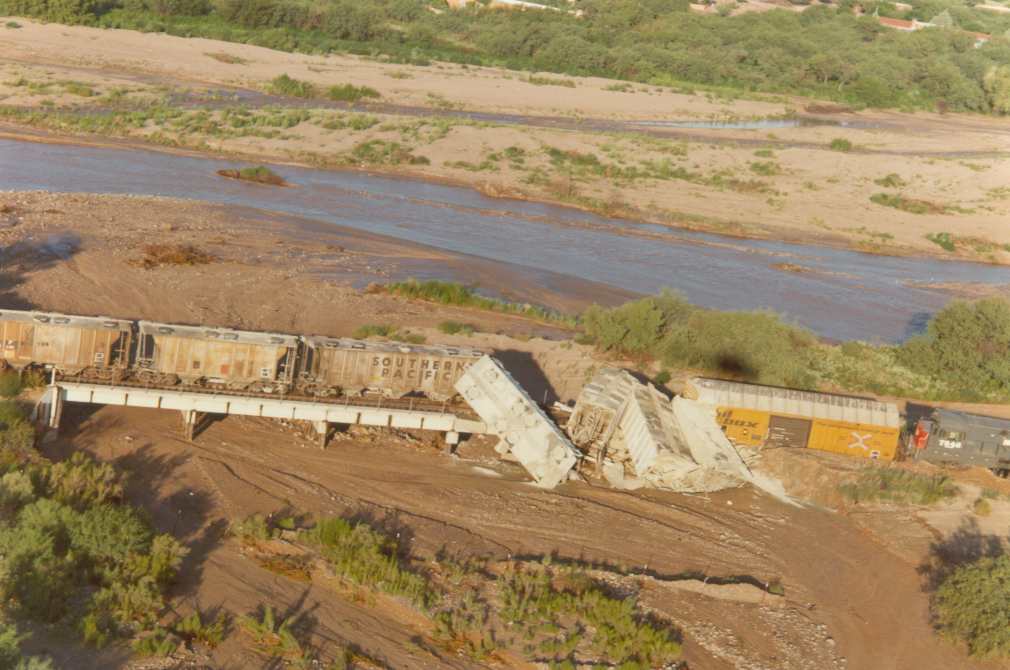
In the photo above it is possible to see the way the water scoured or eroded the soil. It is difficult to see clearly but the actual end of the bridge structure on the right side is about where the left hand car that is tilted at about a 45 degree angle off the bridge into the riverbed. There was a distance of twenty of so feet of track that was suspended under the pile of three cars that are setting at a 90 degree angle to the tracks, in other words just behind the yellow boxcar.
Within the next few days we had additional thunderstorms in the area and lost approximately 2 miles of track because the Santa Cruz River changed it's course and eroded the soil under the roadbed. That is the Santa Cruz in the upper part of the picture. Fortunately we did not loose any more trains. One additional bit of information. Each of the white cars is loaded with approximately 140 tons of bulk cement which makes them difficult to move.
Within two weeks we had another similar derailment approximately 200 miles west of Tucson between Gila Bend and Yuma. The difference in the derailments was that in the second derailment the train was traveling at 70 miles per hour where the one I have just described was only moving at 40 miles per hour. I do not remember how many cars were involved in the second derailment but there were 50 or more stacked in a pile.
In my years on the railroad I personally supervised the clean-up of probably 25 derailments of this magnitude and several hundred minor derailments that occurred in my younger days. Considering that my job was to run a tight ship that would prevent such a thing from happening it is not something to be proud of. I once told my boss that it is a sorry thing when one of your greatest talents is dealing with derailments. He agreed.
At least many of the reasons that caused the derailments in Arizona and New Mexico had been eliminated by the time I retired. Some derailments were the result of the lack of maintenance to the physical plant and equipment over a period of time while the Southern Pacific was a privately owned company.
The problems were fixed while I was there. The reason we were able to make the corrections was the availability of capitol expenditures that were approved about the time I arrived. These improvements cost approximately 400 million dollars and included several hundreds of miles of main line and auxiliary track, many structures and a great deal of new equipment. It was a painful time working around the repair work, coordinating the work itself and maintaining as close to normal operation and maintaining schedules as possible, but the railroad had a wonderful high speed efficient plant in the end.
 Born 08/13/1925
Born 08/13/1925